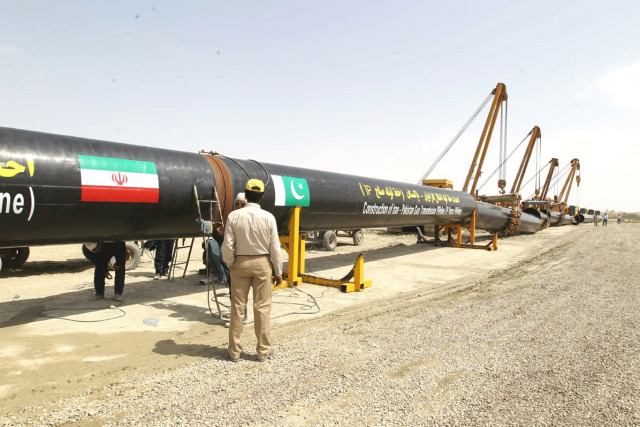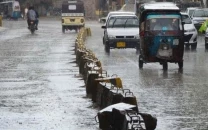Analysis: Iran-Pakistan pipeline a mutually convenient political stunt
Even if everything goes according to plan, Iranian gas will not flow into Pakistan until January 2015.

The IP pipeline makes perfect commercial sense. Iran is desperate for a way to sell its hydrocarbon resources and Pakistan is starved of energy. PHOTO: AFP
Every time a project starts off without both parties having spelled out exactly how they plan to pay for it, it is usually a safe bet that the project will not actually go through. The presidents of both Iran and Pakistan have yet to fully answer the question: for a project that is bitterly opposed by the United States, where exactly do they plan to get the money from?
In a report released to clients on Monday, Bank of America Merrill Lynch, a New York-based investment bank, rated the chances of the pipeline project very slim, for reasons largely to do with the politics of the pipeline. The economics of the project itself are relatively sound, which makes it difficult to dismiss outright. Nonetheless, US and European opposition to the project seems an insurmountable obstacle at this point.
“We do not expect this pipeline to go ahead without at least an implicit go-ahead from the US. In the event that the US continues to oppose this pipeline, we do not see the Pakistan government risking sanctions from the US for the pipeline,” stated the report, compiled by Merrill Lynch’s research affiliate in Pakistan, KASB Securities.
So why go through with it? “We reckon this ground breaking could potentially go down as another popularity attempt by the outgoing Pakistan Peoples Party-led administration,” the report said.
Sound economics
The IP pipeline makes perfect commercial sense. Iran is desperate for a way to sell its hydrocarbon resources and Pakistan is starved of energy. The countries are right next door, making the pipeline not unduly expensive to build.
Bank of American Merrill Lynch estimates that the 750 million cubic feet per day (mmcfd) that the country would be importing from Iran would allow an additional 4,123 megawatts of electricity to be generated in Pakistan. The analysts estimate that the gas will go mostly to utilise the 2,232 megawatts of idle thermal power generation capacity, which would use up about 406 mmcfd, leaving 344 mmcfd for other uses, such as manufacturing fertilisers, or even use by domestic consumers.
And while Pakistan would pay Iran $3 billion a year, it would reduce its oil imports by $5.3 billion, resulting in a net annual reduction in energy imports by about $2.3 billion.
In theory, the pipeline can be paid for: of the estimated $1.5 billion cost of the Pakistan section of the pipeline, Tehran says it will provide a 20-year, $500 million loan, with the remaining amount coming from a gas infrastructure development cess (GIDC) to be levied by Islamabad on Pakistani consumers, by an average of about Rs100 per million British thermal units (mmbtu).
The political hurdle
There is, however, the small matter of US opposition to the project, which will render it effectively impossible for either government to find financing for. Despite all the talk of mutual cooperation between Pakistan and Iran, Islamabad has yet to come even close to violating US and European sanctions against Tehran. Pakistani banks refuse to finance any trade transactions between the two countries, resulting in bilateral trade plummeting 57% between 2010 and 2011. And that is before the harshest sanctions kicked in during 2012.
The banks’ recalcitrance has to do with the caution being exercised by the State Bank of Pakistan. Aware that US and UK regulators are threatening to cut off the ability to do business in dollars and pounds for financial institutions that defy the sanctions, the Pakistani central bank has decided to not to take a chance at all with risking the ire of Washington and London.
It is not just the banks, however. Pakistani energy companies have effectively stopped waiting for Iranian gas and have already begun a process to convert many of their oil-fired power plants to coal, as well as setting up new ones. The Hub Power Company, the Karachi Electric Supply Company, and even some of the captive power plants at textile factories in Punjab have effectively decided that it is better to invest in converting their plants to coal than to wait for Iranian gas, which is a politically dicey proposition at best and a mirage at worst.
Even if everything goes according to plan, Iranian gas will not flow into Pakistan until January 2015, by which time, many if not most privately owned oil-fired power plants will have converted to coal, which is marginally more expensive than Iranian gas, but has the virtue of having no political baggage. If its biggest customers have decided that Iranian gas is not worth it, then who does Tehran plan on selling to?
A mutually convenient stunt
Iran is feeling the sting of sanctions far more than most Pakistanis are aware. According to IMF estimates, oil production has dropped 22% to 2.8 million barrels per day. As a result, Standard & Poor’s, the global credit rating agency, estimates that Iran has the highest “breakeven” price of oil – the price at which revenues from its oil would be sufficient to meet its budgetary needs – among the major oil-producing nations in the world.
Tehran needs oil prices to be above $130 per barrel to sustain itself, according to the S&P. And this is even after harsh austerity measures that have seen subsidies slashed mercilessly. However, oil prices are likely to remain stagnant at well below those levels, according to a recent analysis published by Goldman Sachs, a global investment bank. And given increases in Iraqi oil production, the global market would not miss Iranian oil even if it completely stopped flowing.
In short, Iran is desperate for cash, and Pakistani leaders are desperate enough to be seen to be doing something about the energy crisis for both sides to at least stage the ground-breaking ceremony.
(Read: Pipeline priority)
Published in The Express Tribune, March 13th, 2013.




1735037907-0/Tribune-N-(2)1735037907-0-208x130.webp)














COMMENTS
Comments are moderated and generally will be posted if they are on-topic and not abusive.
For more information, please see our Comments FAQ